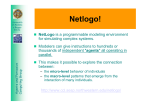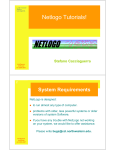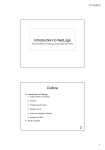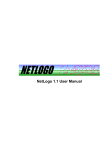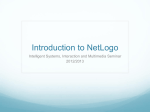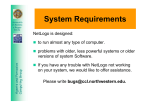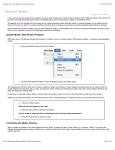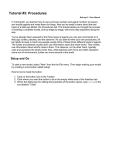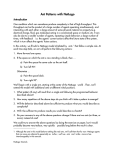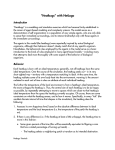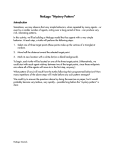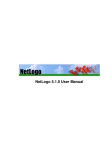Download Netlogo!
Transcript
Netlogo! di Stefano Cacciaguerra Intelligenza Artificiale AA 2006-2007 2 Netlogo! NetLogo is a programmable modeling environment for simulating complex systems. Modelers can give instructions to hundreds or thousands of independent "agents" all operating in parallel. This makes it possible to explore the connection between: the micro-level behavior of individuals the macro-level patterns that emerge from the interaction of many individuals. http://www.ccl.sesp.northwestern.edu/netlogo/ Intelligenza Artificiale AA 2006-2007 Last Version 3.1.3 3 Features You can use the list below to help familiarize yourself with the features NetLogo has to offer. System Language Environment Intelligenza Artificiale AA 2006-2007 4 Features (System) System: Intelligenza Artificiale AA 2006-2007 Cross-platform: runs on MacOS, Windows, Linux, et al Web-enabled (run within a web browser or download and run locally) Models can be saved as applets to be embedded in web pages 5 Features(Language) Language: Intelligenza Artificiale AA 2006-2007 Fully programmable Simple language structure Language is Logo dialect extended to support agents and parallelism Unlimited numbers of agents and variables Double precision arithmetic Many built-in primitives 6 Features (Environment) Environment: Interface builder w/ buttons, sliders, monitors, switches, Plots, text boxes. Intelligenza Artificiale AA 2006-2007 7 What is Netlogo? Intelligenza Artificiale AA 2006-2007 Info area for annotating your model Powerful and flexible plotting system HubNet: participatory simulations using networked devices (including handhelds) Agent Monitors for inspecting agents BehaviorSpace: a tool used to collect data from multiple runs of a model Export and import functions (export data, save and restore state of model) Converts StarLogoT models into NetLogo models 8 Programming Guide The following material explains some important features of programming in NetLogo. Intelligenza Artificiale AA 2006-2007 Agents Procedures Variables Colors Ask Agentsets Breeds Synchronization Procedures (advanced) Lists Strings Turtle Shapes 9 Agents The NetLogo world is made up of agents. Agents are beings that can follow instructions. Each agent can carry out its own activity, all simultaneously. In NetLogo, there are three types of agents: Turtles are agents that move around in the world. The world is two dimensional and is divided up into a grid of patches. Each patch is a square piece of "ground" over which turtles can move. The observer doesn't have a location -- you can imagine it as looking out over the world of turtles and patches. Intelligenza Artificiale AA 2006-2007 10 Patches Intelligenza Artificiale AA 2006-2007 Patches have coordinates. The patch in the center of the world has coordinates (0, 0). We call the patch's coordinates pxcor and pycor : integers. the standard mathematical coordinate plane The total number of patches is determined by the settings screen-edge-x and screen-edge-y. 11 Turtles Turtles have coordinates too: xcor and ycor. The each turtle has an identificator who. For speed, NetLogo always draws a turtle onscreen as if it were standing in the center of its patch, but in fact, the turtle can be positioned at any point within the patch. Intelligenza Artificiale AA 2006-2007 12 Miscellaneous Intelligenza Artificiale AA 2006-2007 The world of patches isn't bounded, but "wraps" so when a turtle moves past the edge of the world, it disappears and reappears on the opposite edge. Every patch has the same number of "neighbor" patches. If you're a patch on the edge of the world, some of your "neighbors" are on the opposite edge. 13 Primitives Commands and reporters tell agents what to do: Commands are actions for the agents to carry out. Reporters carry out some operation and report a result either to a command or another reporter. Commands and reporters built into NetLogo are called Primitives: Intelligenza Artificiale AA 2006-2007 14 Procedures Intelligenza Artificiale AA 2006-2007 Commands and reporters you define yourself are called procedures. Each procedure has a name, preceded by the keyword to. The keyword end marks the end of the commands in the procedure. Once you define a procedure, you can use it elsewhere in your program. Many commands and reporters take inputs values that the command or reporter uses in carrying out its actions. 15 Examples: procedures to setup ca ;; clear the screen crt 10 ;; create 10 new turtles end Intelligenza Artificiale AA 2006-2007 to go ask turtles [ fd 1 ;; all turtles move forward one step rt random 10 ;; ...and turn a random amount lt random 10 ] end 16 Variables A variable can be : Intelligenza Artificiale AA 2006-2007 If a variable is a global variable, there is only one value for the variable, and every agent can access it. Each turtle has its own value for every turtle variable, and each patch has its own value for every patch variable. Some variables are built into NetLogo: all turtles have a color variable, and all patches have a pcolor variable.(The patch variable begins with "p") 17 Variables You can make a global variable by adding a switch or a slider to your model, or by using the globals keyword at the beginning of your code: globals [ clock ] You can also define new turtle and patch variables using the turtles-own and patches-own: turtles-own [ energy speed ] patches-own [ friction ] Use the set command to set them (default value is zero). Global variables can by read and set at any time by any agent. As well, a turtle can read and set patch variables of the patch it is standing on. Intelligenza Artificiale AA 2006-2007 18 Ask Ask specifies commands that are to be run by turtles or patches. All code to be run by turtles must be located in a turtle "context": Intelligenza Artificiale AA 2006-2007 In a button, by choosing "Turtles" from the popup menu. In the Command Center, by choosing "Turtles" from the popup menu. By using ask turtles. The same goes for patches and the observer, except that code to be run by the observer must not be inside any ask. 19 Examples: ask Intelligenza Artificiale AA 2006-2007 to setup ca crt 100 ;; create 100 turtles ask turtles [ set color red ;; turn them red rt random 360 ;; give them random headings fd 50 ;; spread them around ] ask patches [ if (pxcor > 0) ;; patches on the right side [set pcolor green ] ;; of the screen turn green ] end 20 Ask You can also use ask to make an individual turtle or patch run commands. The reporters turtle, patch, and patch-at are useful for this technique: Intelligenza Artificiale AA 2006-2007 to setup ca crt 3 ;; make 3 turtles ask turtle 0 ;; tell the first one... [ fd 1 ] ;; ...to go forward ask turtle 1 ;; tell the second one... [ set color green ] ;; ...to become green ask patch 2 -2 ;; ask the patch at coords (2,-2) [ set pcolor blue ] ;; ...to become blue ask turtle 0 ;; ask the first turtle [ ask patch-at 1 0 ;; ...to ask patch to the east [ set pcolor red ]] ;; ...to become red end 21 Ask Intelligenza Artificiale AA 2006-2007 Every turtle created has an ID number. The first turtle created has ID 0, the second turtle ID 1, and so forth. The turtle primitive reporter takes an ID number as an input, and reports the turtle with that ID number. The patch primitive reporter takes values for pxcor and pycor and reports the patch with those coordinates. The patch-at primitive reporter takes offsets: distances, in the x and y directions, from the first agent. 22 Agentsets An agentset is a set of agents and it can contain either turtles or patches, but not both at once. Intelligenza Artificiale AA 2006-2007 You can construct agentsets that contain only some turtles or some patches. For example, all the red turtles, or the patches with pxcor equal one. These agentsets can then be used by ask or by various reporters that take agentsets as inputs. 23 Agentsets Intelligenza Artificiale AA 2006-2007 Using turtles-here or turtles-at to make an agentset containing only the turtles on my patch, or only the turtles on some other particular patch. turtles turtles with [color = red] ;; all red turtles turtles-here with [color = red] ;; all red turtles on my patch turtles in-radius 3 ;; all turtles less than 3 patches away patches patches with [pxcor > 0] ;; patches on right side of screen ;; the four patches to the east, north, west, and south patches at-points [[1 0] [0 1] [-1 0] [0 -1]] Neighbors ;; shorthand for those eight patches 24 Agentsets Here are some simple things you can do: Use ask to make the agents in the agentset do something Use any to see if the agentset is empty Use count to find out how many agents are in the set Intelligenza Artificiale AA 2006-2007 Here are some more complex things you can do: random-one-of, sprout, max-one-of or min-one-of histogram, values-from 25 Breeds You can define different "breeds" of turtles. The different breeds can behave differently. You define breeds using the breeds keyword, at the top of your model, before any procedures: breeds [wolves sheep] When you define a breed such as sheep, an agentset for that breed is automatically created, so that all of the agentset capabilities described above are immediately available with the sheep agentset. The following new primitives are also automatically available once you define a breed: create-sheep, create-custom-sheep, sheep-here, and sheep-at. Intelligenza Artificiale AA 2006-2007 Also, you can use sheep-own to define new turtle variables that only turtles of the given breed have. 26 Breeds Intelligenza Artificiale AA 2006-2007 A turtle's breed agentset is stored in the breed turtle variable. So you can test a turtle's breed, like this: if breed = wolves [... ] Note also that turtles can change breeds. A wolf doesn't have to remain a wolf its whole life. ask random-one-of wolves [ set breed sheep ] breeds [sheep wolves] sheep-own [grass] to setup ca create-custom-sheep 50 [ set color white] create-custom-wolves 50 [ set color black ] end 27 Synchronization Turtle commands are executed asynchronously; each turtle does its list of commands as fast as it can. One could make the turtles "line up" by waiting the end of an ask block. At that point, the turtles would wait until all were finished before any went on. Intelligenza Artificiale AA 2006-2007 the two steps are not synced: ask turtles [ fd random 10 do-calculation ] the two steps are synced : ask turtles [ fd random 10 ] ask turtles [ do-calculation ] 28 Procedures with inputs Your own procedures can take inputs, just like primitives do. To create a procedure that accepts inputs, include a list of input names in square brackets after the procedure name: to draw-polygon [num-sides size] pd repeat num-sides [ fd size rt (360 / num-sides) ] end Intelligenza Artificiale AA 2006-2007 29 Reporter procedures You can define your own reporters. You must do two special things: Intelligenza Artificiale AA 2006-2007 First, use to-report instead of to to begin your procedure. Second, in the body of the procedure, use report to report the value you want to report. to-report absolute-value [number] ifelse number >= 0 [ report number ] [ report 0 - number ] end 30 Procedures with local variables A local variables is defined and used only in the context of a particular procedure. To add a local variable to your procedure, use the locals keyword. It must come at the beginning of your procedure: Intelligenza Artificiale AA 2006-2007 to swap-colors [turtle1 turtle2] locals [temp] set temp color-of turtle1 set (color-of turtle1) (color-of turtle2) set (color-of turtle2) temp end 31 Lists In the simplest models, each variable holds only one piece of information, usually a number or a string. The list feature lets you store multiple pieces of information in a single variable by collecting those pieces of information in a list. Each value in the list can be any type of value: a number, or a string, an agent or agentset, or even another list. Lists allow for the convenient packaging of information in NetLogo. If your agents carry out a repetitive calculation on multiple variables, it might be easier to have a list variable, instead of multiple number variables. Intelligenza Artificiale AA 2006-2007 32 Constant Lists You can make a list by simply putting the values you want in the list between brackets, like this: set mylist [2 4 6 8] Note that the individual values are separated by spaces. You can make lists that contains numbers and strings this way, as well as lists within lists: set mylist [[2 4] [3 5]] Intelligenza Artificiale AA 2006-2007 The empty list is written by putting nothing between the brackets, like this: []. 33 Building Lists on the Fly The list reporter accepts two other reporters, runs them, and reports the results as a list. If you wanted a list to contain two random values, you might use the following code: set random-list list (random 10) (random 20) This will set random-list to a new list of two random numbers each time it runs. To make longer lists, use the list reporter with the sentence reporter, which concatenates two lists (combines their contents into a single, larger list). Intelligenza Artificiale AA 2006-2007 34 Building Lists on the Fly The values-from primitive lets you construct a list from an agentset. It reports a list containing the each agent's value for the given reporter. The reporter could be a simple variable name, or a more complex expression -- even a call to a procedure defined using to-report. A common idiom is max values-from turtles [...] Intelligenza Artificiale AA 2006-2007 sum values-from turtles [...] 35 Changing List Items The replace-item replace index element in the list with new value. ( 0 means the first item, 1 means the second item, and so forth) replace-item index list value set mylist [2 7 5 B [3 0 -2]] ; mylist is now [2 7 5 B [3 0 -2]] set mylist replace-item 2 mylist 10 ; mylist is now [2 7 10 B [3 0 -2]] To add an item, say 42, to the end of a list, use the lput reporter. (fput adds an item to the beginning of a list.) set mylist lput 42 mylist ; mylist is now [2 7 10 B [3 0 -2] 42] Intelligenza Artificiale AA 2006-2007 36 Changing List Items The but-last reporter reports all the list items but the last. set mylist but-last mylist ; mylist is now [2 7 10 B [3 0 -2]] Suppose you want to get rid of item 0, the 2 at the beginning of the list (but-first). set mylist but-first mylist ; mylist is now [7 10 B [3 0 -2]] Intelligenza Artificiale AA 2006-2007 37 Strings Intelligenza Artificiale AA 2006-2007 To input a constant string, surround it with double quotes(The empty string is written like this: ""). Most of the list primitives work on strings as well: butfirst "string" => "tring" butlast "string" => "strin" empty? "" => true empty? "string" => false first "string" => "s" item 2 "string" => "r" last "string" => "g" length "string" => 6 38 Strings member? "s" "string" => true member? "rin" "string" => true member? "ron" "string" => false position "s" "string" => 0 position "rin" "string" => 2 position "ron" "string" => false remove "r" "string" => "sting" remove "s" "strings" => "tring" replace-item 3 "string" "o" => "strong" reverse "string" => "gnirts" Intelligenza Artificiale AA 2006-2007 39 Strings Strings can be compared using the =, !=, <, >, <=, and >= operators. To concatenate strings, that is, combine them into a single string, you may also use the + (plus) operator: "tur" + "tle" => "turtle“ If you need to embed a special character in a string, use the following escape sequences: \n = newline (carriage return) \t = tab \" = double quote \\ = backslash Intelligenza Artificiale AA 2006-2007 40 Scripting Intelligenza Artificiale AA 2006-2007 Turtle shapes are vector shapes. They are built up from basic geometric shapes; squares, circles, and lines, rather than a grid of pixels. Vector shapes are fully scalable and rotatable. A turtle's shape is stored in its shape variable and can be set using the set command. The set-default-shape primitive is useful for changing the default turtle shape to a different shape, or having a different default turtle shape for each breed of turtle. Use the Shapes Editor to create your own turtle shapes. 41 Shapes Editor Use the Shapes Editor to create your own turtle shapes Intelligenza Artificiale AA 2006-2007 42 References In the Netlogo site you can find: the last version of Netlogo the Netlogo User Manual the new Netlogo model and a group-discussion about Netlogo http://www.ccl.sesp.northwestern.edu/netlogo/ Intelligenza Artificiale AA 2006-2007





















